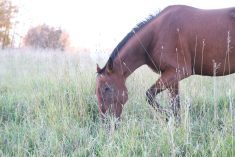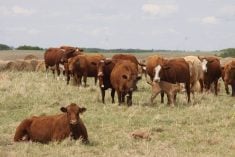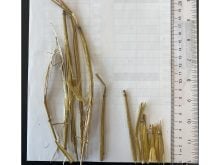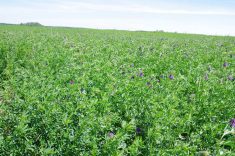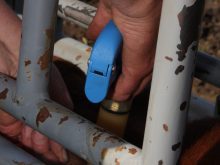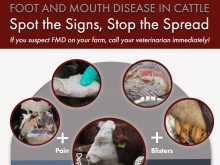CARMAN, Man. — Standing on a patch of bare soil and next to a plot of corn in south-central Manitoba, Talyia Tober delivered a two-minute explanation of her research on corn grazing and seeding high-protein forage crops between the rows of corn.
Then the questions started.
A group of agronomists, scientists and others touring the University of Manitoba’s research farm near Carman peppered Tober with nine or 10 questions to learn more about her project.
Tober handled all the queries and gave clear explanations to the questions, including the obvious one — why are you doing this research?
Read Also

House ag committee to undertake several studies
The House of Commons standing agriculture committee has set its agenda for the coming months. Members began the fall sitting with a two-hour update on international trade
Corn grazing has become commonplace in parts of Western Canada because cattle producers like the practice’s simplicity.
It’s relatively easy to grow corn and then put cattle into the corn field for part of the fall and winter, where the cows will graze on the cobs, leaves and stems.
“If you can figure out a way to fence and have the cattle go out and graze, they’re doing all the work for you,” said Tober, a master’s student in the U of M’s department of animal science.
“We can feed a lot of cattle in a small area of land. That’s why corn (grazing) works so well.”
However, there’s one problem — corn is low in crude protein.
Depending on where it is grown, the crude protein could be around 7.5 per cent, “which is too low to meet all the nutrient requirements of beef cattle when they’re grazing,” Tober told tour groups at the university’s plant science field day held earlier this summer near Carman.
One solution is to supplement the cattle’s feed with a forage such as alfalfa.
However, Tober and her fellow U of M researchers believe there’s another option — seeding high protein forages between the rows of corn.
“By having an intercrop, we’re (providing) a diet that meets all their nutritional needs,” Tober said.
To nail down the agronomics of growing corn with an intercrop, Tober and others have seeded corn in plots at Carman and at another research farm in Glenlea, Man.
“The results of this experiment can help farmers select intercrop establishment methods to optimize the production of corn and intercrop for fall and winter grazing, silage corn and fall cover crop, or grain corn and fall cover crop,” says a university summary of the project.
The researchers selected a mixture of species for the intercrop, which included Italian ryegrass, crimson clover, red clover, hairy vetch and Graza radish.
In 2023, the corn was planted in May or June and the intercrop mixture was seeded when the corn reached the V4 stage, around the first week of July.
One agronomic question they studied was row spacing. What spacing will allow the intercrop species to grow but also produce a sufficient amount of corn biomass for grazing?
The researchers tried 30 inch and 60 inch row spacings in the experiment, with a seeding rate of 36,000 plants per acre in the 30 inch treatment and 18,000 plants per acre in the 60 inch treatment.
It’s unusual to plant corn with 60 inch spacing, but the scientists are trying to find a balance that supports both the corn and the intercrop. Corn provides a huge amount of energy for grazing cattle, but less biomass is acceptable if there’s protein in the mix.
“If we’re getting more protein by intercropping, that’s the trade-off we’re getting,” Tober said.
Yvonne Lawley, a U of M plant scientist who studies cover crops, asked Tober about the growth of the intercrop mixture in 2023.
“Last fall we had a long shoulder season. We got the right moisture … we had heat. That resulted in huge, intercrop biomass,” Tober said.
“We saw the intercrop at least double, if not more than double.”
Tober is evaluating the agronomics of the corn-forage mix intercrop again this year at the Carman research centre.
Lawley has been studying the concept of growing corn with high protein intercrops for several years.
With funding from the Beef Cattle Research Council, Lawley and her team conducted trials on forages between rows of corn in 2019. The yield of the intercrop was less than expected because 2019 was a drought year.
“(But) given the high crude protein value of these intercropped forages, further evaluation of intercropped corn under non-drought conditions is warranted,” says a BCRC summary of the project.
“This proof of concept project showed that intercropping legumes with corn can provide the dietary requirements for cows. Next steps include determining how cows respond to grazing these crop mixes.”
Tober said U of M scientists have completed a field scale study to evaluate how cattle react to a mixture of corn and high protein forages.
“I believe it was from October to December that they grazed,” Tober said, adding it’s tricky to do such a study because cattle are selective in what they will eat.
In this case, they first consumed the high forage species between the rows of corn because it was lush and green.
“They went after the intercrop and then went and started eating the dried down corn,” she said.
“They’re going to selectively graze how they want to. It changes the nutrient value available to them … because they’re being so selective.”
This sort of selective eating is comparable to a human eating kale for three weeks followed by a month of corn flakes.
It might be healthier to eat both corn flakes and kale on the same day.
Nonetheless, Tober and others involved in the project think an intercrop of corn with a high protein forage could improve the efficiency and productivity of corn grazing.
“Hopefully, that (grazing study) gets published in the next little bit, so that producers can use it and implement (this) in the future,” she said.






